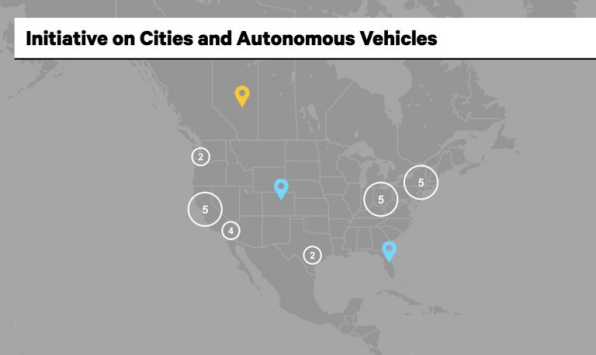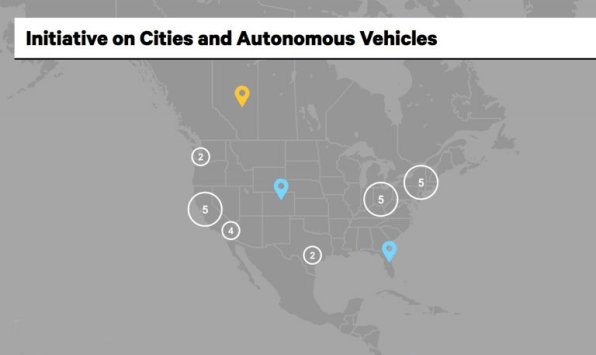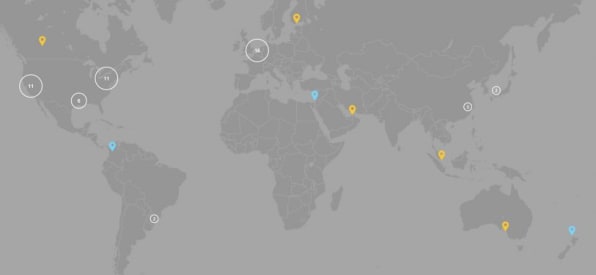
06 Nov This Atlas Maps How Driverless Cars May Change The World
In San Jose, California, where the population is expected to increase 40% with nearly a half-million new residents by 2040, the rise of driverless cars could offer residents dealing with the affordable housing crisis some relief: If the city can create an autonomous shuttle and taxi system, for instance, fewer people would need to own cars, which means existing parking lots and even some roads could be repurposed for more residential space. The city is actually considering that, and running a series of tests to figure out if it’s feasible.
It’s the sort of idea that other local governments might want to copy—and just one example of several dozen radical experiments happening around the world. The problem is that cities don’t really know who else is doing the innovating. To speed that learning curve and ensure that great ideas have a chance to spread, Bloomberg Philanthropies and the Aspen Institute, created the Global Atlas of Autonomous Vehicles in Cities, an interactive map of what initiatives are happening in different metros around the world, what partners are involved, and how quickly things are progressing.

So far, AV atlas is tracking city early efforts in 53 places, 35 of which are in the midst of piloting projects while the other 18 are working on the right regulatory, planning and government assessments to move forward. The effort is international, with Paris, Helsinki, Tel Aviv, Buenos Aires, and Sao Paulo sharing lessons.
“We wanted to create a platform and a way for cities to start articulating their own vision for the future and to start expressing or talking with each other about the problems and opportunities,” says James Anderson, the head of Bloomberg’s Government Innovation program. “Because when cities do that they get smarter together. They raise their own ambitions.”
That model of connecting mayors in a way that allows each to benefit and lift each other up is classic Bloomberg Philanthropies. The Government Innovation group, which has made “Bloombergize” a fairly well-known verb in urban development circles, is known for its efforts encouraging mayors to dream up forward-looking plans to tackle major civic issues, and then pouring hundreds of millions into making those concepts a reality. That work, alongside a series of data-driven initiatives that let city leaders track social and economic progress, has helped the philanthropy affirm that world change can start at a city level. And that what works in one place might well be transportable to another somewhere else in the world.

The mapping project, however, stems from another crucial fact. “Intentional city planning for autonomous vehicles is new,” notes a report that accompanies the map. Bloomberg Philanthropies became intentional about solving this back in 2016, when the organization and Aspen Institute created a global team of mayors to begin thinking about how the revolution might best serve citizens. Since then, the group has surveyed 38 cities now actively working in the area, the nonprofit found that nearly 25% started within the last year. Overall, 75% have initiatives less than 36 months old. Among those respondent, however, there are some big dreams: The most anticipated use for AVs is as a connector for “last-mile transit” or connecting current public transit systems to people that can benefit from them but don’t a way to get to or from the closest start point. Other visions include a new kind of taxi, mass transit, and freight shuttle.
That’s just to start. More proactively, plans like the one San Jose is considering could perhaps cure some of the ailments caused by the current way that cars work—and the sort of sprawl, and shortsighted, reactionary urban planning that accompanied motorized transportation to begin with. “We learned a lot from the first automobile revolution that really happened to our cities,” Anderson says. “We need the next automobile revolution to happen for citizens. We need for this technology to help address some of the very concrete and stubborn problems that cities have.”
To that end, cities could ensure that robo-taxis are part of a program to connect disadvantaged people with opportunities like jobs or housing in areas that might otherwise not have been able to access. More blue sky, Anderson has heard mayors talk about using AV’s to improve emergency response times, and to address social isolation among senior citizens. Some of the proposals in the atlas lay out ambitions like this, creating an obvious enticement for industry groups to understand the emerging market and potential partners.
“Our belief has been that the likelihood of autonomous vehicles helping cities address those kinds of problems increases exponentially when industry is in a conversation with cities, and it will likely not happen if they’re not,” Anderson says. “This is why Bloomberg Philanthropies wanted to really zero in and focus on those challenges and opportunities from the city perspective, from a citizen-centered perspective, and offer [the results] up to industry, so that industry can do what it does best: innovate and come up with the most cutting-edge and applicable responses that help cities solve those problems.”
Bloomberg tracked what bureaucratic roadblocks cities are most concerned with too, which is an additional part of the equation. The biggest issues so far appears to be a lack of funding, no internal capacity to manage pilots (which more funding might solve), and that many places are unclear exactly how to speed up progress, according to their survey results. The Atlas should grow and evolve, picking up hitchhikers–there’s a link for cities who aren’t yet listed to start publicly sharing.
“In a field that is changing so quickly, increasing the capacity of cities to talk with each other and understand happening in other places is critical,” Anderson adds. “And yet before the map it was virtually impossible. That’s what we’re trying to solve for here.”
Source: Fast Company




Sorry, the comment form is closed at this time.